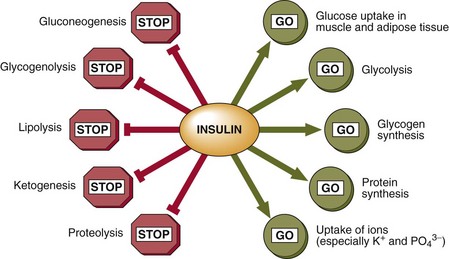31 Dietary carbohydrate is digested in the gastrointestinal tract to simple monosaccharides, which are then absorbed. Starch provides glucose directly, while fructose (from dietary sucrose) and galactose (from dietary lactose) are absorbed and also converted into glucose in the liver. Glucose is the common carbohydrate currency of the body. Figure 31.1 shows the different metabolic processes that affect the blood glucose concentration. This level is, as always, the result of a balance between input and output, synthesis and catabolism. Insulin signals the fed state. It switches on pathways and processes involved in the cellular uptake and storage of metabolic fuels, and switches off pathways involved in fuel breakdown (Fig 31.2). It should be noted that glucose cannot enter the cells of most body tissues in the absence of insulin. Primary diabetes mellitus is generally subclassified into Type 1 or Type 2. These clinical entities differ in epidemiology, clinical features and pathophysiology. The contrasting features of Types 1 and 2 diabetes mellitus are shown in Table 31.1. Table 31.1 Type 1 versus Type 2 diabetes mellitus
Glucose metabolism and diabetes mellitus
Insulin
Diabetes mellitus
Main features
Type 1
Type 2
Epidemiology
Frequency in northern Europe
0.02–0.4%
1–3%
Predominance
N. European
Worldwide
Caucasians
Lowest in rural areas of developing countries ![]()
Stay updated, free articles. Join our Telegram channel

Full access? Get Clinical Tree

 Get Clinical Tree app for offline access
Get Clinical Tree app for offline access


